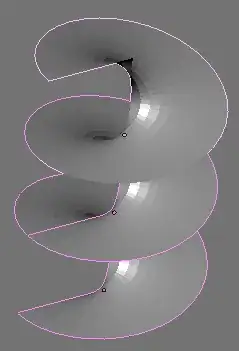Do all non-conservative vector fields (in 2-space) have corresponding surfaces that are periodic or discontinuous?
No. Non-conservative vector fields can be produced through many other vector potentials. By Helmholtz decomposition, a smooth vector field $F$ can be decomposition into a conservative vector field plus a rotation of some other conservative field:
$$
F = \nabla \phi + \nabla^{\perp} \psi,
$$
where $\nabla^{\perp}$ is like embedding the the 3D curl operator for scalar function in 2D:
$$
\boldsymbol{C}^{1}(\mathbb{R}^2) \hookrightarrow \boldsymbol{C}^{1}(\mathbb{R}^3),
\\
\nabla^{\perp} \psi(x,y) : = \left(\frac{\partial \psi}{\partial y},-\frac{\partial \psi}{\partial x}\right)\mapsto \left(\frac{\partial \psi}{\partial y},-\frac{\partial \psi}{\partial x},0\right) = \nabla\times (0,0,\psi).
$$
Ignoring the conservative part of $F$, we can produce all sorts of non-conservative part of $F$ in $\mathbb{R}^2$ using very "smooth" potential $\psi$, neither periodic nor discontinuous. For example: let $\psi = e^{-x^2-y^2}/2$
$$
F = \nabla^{\perp}\psi = (- y\psi, x\psi).
$$
You can easily check the field you gave is $\nabla^{\perp} xy$, a rotation of the conservative vector field $(x,y)$.
In fact, a $90^{\circ}$ degree rotation of any conservative vector field in $\mathbb{R}^2$ will make it non-conservative.
The surface corresponding to the vector field $F= (y,-x)$ is continuous but periodic, spiraling along the $z$-axis.
As joriki pointed out in the comments, the vector field generated by the spiral you gave is similar to "the gradient field of the polar angle"
$$
F = \nabla \arctan \left(\frac{y}{x}\right) = \left(\frac{-y}{x^2+y^2},\frac{x}{x^2+y^2}\right). \tag{1}
$$
If the domain contains a curve winding around the origin, then this is not conservative. Otherwise, it is conservative indeed. Like you did there, we let $z$ be parametrized so that we glue different branches of $\arg (x+iy)$ together, the gradient flow is non-conservative. For a more detailed discussion you could refer to my answer here. Roughly the summary is:
$$
\text{zero curl} + \text{simply-connectedness of the domain} \implies \text{conservative}
\\
\text{gradient} + \text{no singularities in the domain} \implies \text{conservative}
$$
Notice "curl zero" means $0$ everywhere, not like (1), if you include $\{0\}$ to make the domain simply-connected, then the curl is zero except this very point.
Lastly, to address your question again, the non-conservative field you found using that potential ("spiral") is actually a special kind among other non-conservative fields. It is a gradient, but it is not conservative (integral around a close path is non-zero).
